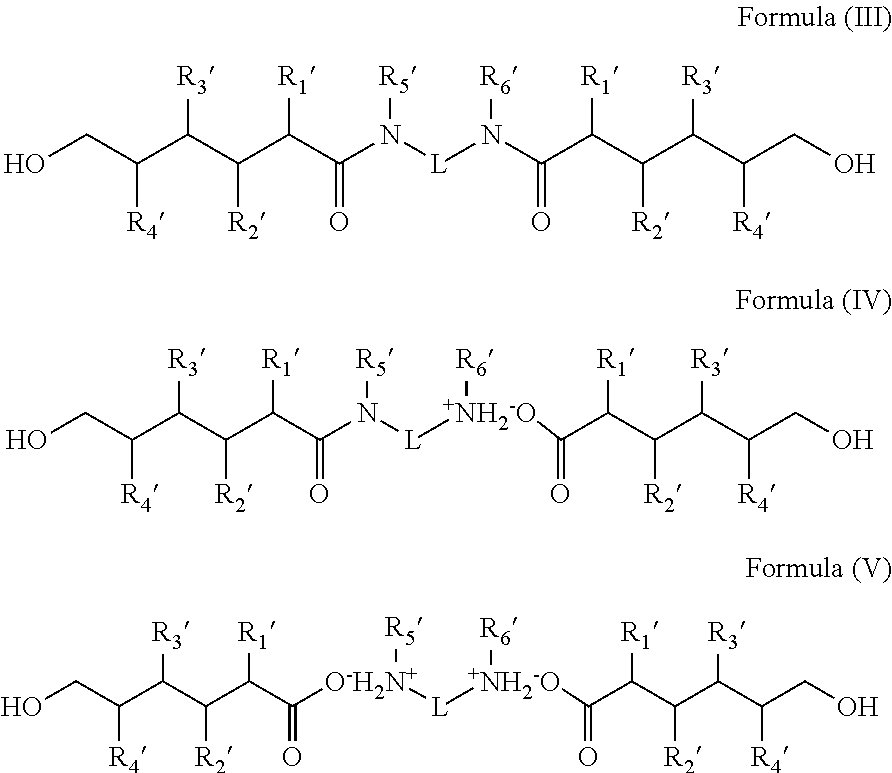Method of strengthening hair fibers and protecting dyed hair color from fading or wash-out
a technology of hair fibers and dyed hair, which is applied in the direction of hair cosmetics, organic chemistry, toilet preparations, etc., can solve the problems of hair dries and becomes brittle, hair can suffer damage from a number of sources, and hair fiber damage can be found
- Summary
- Abstract
- Description
- Claims
- Application Information
AI Technical Summary
Benefits of technology
Problems solved by technology
Method used
Image
Examples
example 1
Reaction of Gluconolactone with Ethylene Diamine in Water
[0072]3.2 g ethylene diamine (EDA), 23.9 g water and 35.6 g L-gluconic acid delta-lactone (GDL) were sequentially added into a 3-neck flask to form a mixture. Under nitrogen, the mixture was gradually heated to about 60° C. and kept for about 2.5 hours. Then, the temperature was decreased to 50° C. and the formed end product was poured into a container. Once the temperature was lowered to room temperature (˜21-23° C.), the end product was obtained. Analytical results showed that the end product included N,N′-ethylenebis-D-gluconamide, N-(2-aminoethyl)-D-gluconamide, and GDL.
example 2
Reaction of GDL with Ethanolamine in Water
[0073]6.16 g ethanolamine (EA), 15 g water and 17.9 g L-gluconic acid delta-lactone were sequentially added into a 3-neck flask to form a mixture. Under nitrogen, the mixture was gradually heated to about 60° C. and kept at that temperature for about 2.5 hours. Then, the temperature was decreased to 50° C. and the formed end product was poured into a container. Once the temperature was lowered to room temperature (˜21-23° C.), the end product was obtained.
example 3
Reaction of FDL with Ethylene Diamine in Methanol
[0074]2.40 g ethylenediamine, 79 g methanol and 14.26 g L-gluconic acid delta-lactone were sequentially added into a 3-neck flask to form a mixture. Under nitrogen, the mixture was gradually heated to reflux and kept at that temperature for about 2.5 hours. Then, the temperature was decreased to room temperature (˜21-23° C.). The final product was filtered and dried. The white powder product was obtained.
PUM
| Property | Measurement | Unit |
|---|---|---|
| Temperature | aaaaa | aaaaa |
| Temperature | aaaaa | aaaaa |
| Temperature | aaaaa | aaaaa |
Abstract
Description
Claims
Application Information
 Login to View More
Login to View More - R&D
- Intellectual Property
- Life Sciences
- Materials
- Tech Scout
- Unparalleled Data Quality
- Higher Quality Content
- 60% Fewer Hallucinations
Browse by: Latest US Patents, China's latest patents, Technical Efficacy Thesaurus, Application Domain, Technology Topic, Popular Technical Reports.
© 2025 PatSnap. All rights reserved.Legal|Privacy policy|Modern Slavery Act Transparency Statement|Sitemap|About US| Contact US: help@patsnap.com



